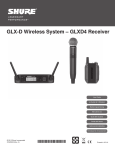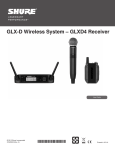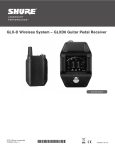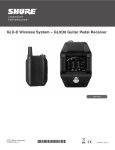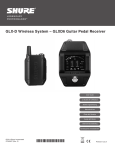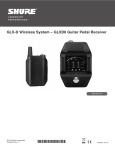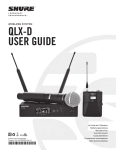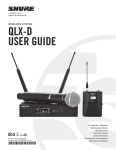Download American Audio Q-2422 - AUTRE Specifications
Transcript
GLXD4 Wireless Receiver © 2013 Shure Incorporated 27A20555 (Rev. 1) Printed in U.S.A. IMPORTANT SAFETY INSTRUCTIONS 1. 2. 3. 4. 5. 6. 7. 8. 9. 10. 11. 12. 13. READ these instructions. KEEP these instructions. HEED all warnings. FOLLOW all instructions. DO NOT use this apparatus near water. CLEAN ONLY with dry cloth. DO NOT block any ventilation openings. Allow sufficient distances for adequate ventilation and install in accordance with the manufacturer’s instructions. DO NOT install near any heat sources such as open flames, radiators, heat registers, stoves, or other apparatus (including amplifiers) that produce heat. Do not place any open flame sources on the product. DO NOT defeat the safety purpose of the polarized or groundingtype plug. A polarized plug has two blades with one wider than the other. A grounding type plug has two blades and a third grounding prong. The wider blade or the third prong are provided for your safety. If the provided plug does not fit into your outlet, consult an electrician for replacement of the obsolete outlet. PROTECT the power cord from being walked on or pinched, particularly at plugs, convenience receptacles, and the point where they exit from the apparatus. ONLY USE attachments/accessories specified by the manufacturer. USE only with a cart, stand, tripod, bracket, or table specified by the manufacturer, or sold with the apparatus. When a cart is used, use caution when moving the cart/apparatus combination to avoid injury from tip-over. UNPLUG this apparatus during lightning storms or when unused for long periods of time. CONSIGNES DE SÉCURITÉ IMPORTANTES 1. 2. 3. 4. 5. 6. 7. LIRE ces consignes. CONSERVER ces consignes. OBSERVER tous les avertissements. SUIVRE toutes les consignes. NE PAS utiliser cet appareil à proximité de l'eau. NETTOYER UNIQUEMENT avec un chiffon sec. NE PAS obstruer les ouvertures de ventilation. Laisser des distances suffisantes pour permettre une ventilation adéquate et effectuer l'installation en respectant les instructions du fabricant. 8. NE PAS installer à proximité d'une source de chaleur telle qu'une flamme nue, un radiateur, une bouche de chaleur, un poêle ou d'autres appareils (dont les amplificateurs) produisant de la chaleur. Ne placer aucune source à flamme nue sur le produit. 9. NE PAS détériorer la sécurité de la fiche polarisée ou de la fiche de terre. Une fiche polarisée comporte deux lames dont l'une est plus large que l'autre. Une fiche de terre comporte deux lames et une troisième broche de mise à la terre. La lame la plus large ou la troisième broche assure la sécurité de l'utilisateur. Si la fiche fournie ne s'adapte pas à la prise électrique, demander à un électricien de remplacer la prise hors normes. 10. PROTÉGER le cordon d'alimentation afin que personne ne marche dessus et que rien ne le pince, en particulier au niveau des fiches, des prises de courant et du point de sortie de l'appareil. 11. UTILISER UNIQUEMENT les accessoires spécifiés par le fabricant. 12. UTILISER uniquement avec un chariot, un pied, un trépied, un support ou une table spécifié par le fabricant ou vendu avec l'appareil. Si un chariot est utilisé, déplacer l'ensemble chariot-appareil avec précaution afin de ne pas le renverser, ce qui pourrait entraîner des blessures. INSTRUCCIONES IMPORTANTES DE SEGURIDAD 1. 2. 3. 4. 5. 6. 7. LEA estas instrucciones. CONSERVE estas instrucciones. PRESTE ATENCION a todas las advertencias. SIGA todas las instrucciones. NO utilice este aparato cerca del agua. LIMPIE UNICAMENTE con un trapo seco. NO obstruya ninguna de las aberturas de ventilación. Deje espacio suficiente para proporcionar ventilación adecuada e instale los equipos según las instrucciones del fabricante. 8. NO instale el aparato cerca de fuentes de calor tales como llamas descubiertas, radiadores, registros de calefacción, estufas u otros aparatos (incluyendo amplificadores) que produzcan calor. No coloque artículos con llamas descubiertas en el producto. 9. NO anule la función de seguridad del enchufe polarizado o con clavija de puesta a tierra. Un enchufe polarizado tiene dos patas, una más ancha que la otra. Un enchufe con puesta a tierra tiene dos patas y una tercera clavija con puesta a tierra. La pata más ancha o la tercera clavija se proporciona para su seguridad. Si el tomacorriente no es del tipo apropiado para el enchufe, consulte a un electricista para que sustituya el tomacorriente de estilo anticuado. 10. PROTEJA el cable eléctrico para evitar que personas lo pisen o estrujen, particularmente en sus enchufes, en los tomacorrientes y en el punto en el cual sale del aparato. 11. UTILICE únicamente los accesorios especificados por el fabricante. 12. UTILICE únicamente con un carro, pedestal, trípode, escuadra o mesa del tipo especificado por el fabricante o vendido con el aparato. Si se usa un carro, el mismo debe moverse con sumo cuidado para evitar que se vuelque con el aparato. IMPORTANTES INSTRUÇÕES DE SEGURANÇA 1. 2. 3. 4. 5. 6. 7. LEIA estas instruções. GUARDE estas instruções. PRESTE ATENÇÃO a todas as instruções. SIGA todas as instruções. NÃO use este aparelho perto de água. LIMPE SOMENTE com um pano seco. NÃO bloqueie nenhuma das aberturas de ventilação. Deixe distâncias suficientes para ventilação adequada e instale de acordo com as instruções do fabricante. 8. NÃO instale próximo de nenhuma fonte de calor, tais como fogo aceso, radiadores, bocais de aquecimento, fornos ou outros aparelhos que produzam calor (inclusive amplificadores). Não coloque fontes de chamas sobre o produto. 9. NÃO inutilize as características de segurança do conector polarizado ou com pino de aterramento. Um conector polarizado possui duas lâminas com uma mais larga do que a outra. Um conector com pino de aterramento possui duas lâminas e um terceiro pino de aterramento. É fornecida uma lâmina mais larga ou o terceiro pino para a sua segurança. Se por acaso o conector não se encaixar na tomada, chame um eletricista para substituir a tomada obsoleta. 10. PROTEJA o cabo de alimentação, evitando que seja pisado ou que enrosque, especialmente nos conectores, nas tomadas elétricas de emprego geral e no ponto onde elas saem do aparelho. 11. USE SOMENTE acessórios/apetrechos especificados pelo fabricante. 12. USE somente com um carrinho, pedestal, tripé, suporte ou mesa especificados pelo fabricante ou vendidos com o aparelho. Quando utilizar um carrinho, tenha cuidado ao movimentar o conjunto aparelho/carrinho para evitar danos com a queda do mesmo. 14. REFER all servicing to qualified service personnel. Servicing is required when the apparatus has been damaged in any way, such as power supply cord or plug is damaged, liquid has been spilled or objects have fallen into the apparatus, the apparatus has been exposed to rain or moisture, does not operate normally, or has been dropped. 15. DO NOT expose the apparatus to dripping and splashing. DO NOT put objects filled with liquids, such as vases, on the apparatus. 16. The MAINS plug or an appliance coupler shall remain readily operable. 17. The airborne noise of the Apparatus does not exceed 70dB (A). 18. Apparatus with CLASS I construction shall be connected to a MAINS socket outlet with a protective earthing connection. 19. To reduce the risk of fire or electric shock, do not expose this apparatus to rain or moisture. 20. Do not attempt to modify this product. Doing so could result in personal injury and/or product failure. 21. Operate this product within its specified operating temperature range. This symbol indicates that dangerous voltage constituting a risk of electric shock is present within this unit. This symbol indicates that there are important operating and maintenance instructions in the literature accompanying this unit. WARNING: This product contains a chemical known to the State of California to cause cancer and birth defects or other reproductive harm. 13. DÉBRANCHER l'appareil pendant les orages ou quand il ne sera pas utilisé pendant longtemps. 14. CONFIER toute réparation à du personnel qualifié. Des réparations sont nécessaires si l'appareil est endommagé d'une façon quelconque, par exemple : cordon ou prise d'alimentation endommagé, liquide renversé ou objet tombé à l'intérieur de l'appareil, exposition de l'appareil à la pluie ou à l'humidité, appareil qui ne marche pas normalement ou que l'on a fait tomber. 15. NE PAS exposer cet appareil aux égouttures et aux éclaboussements. NE PAS poser des objets contenant de l'eau, comme des vases, sur l'appareil. 16. La prise SECTEUR ou un coupleur d’appareil électrique doit rester facilement utilisable. 17. Le bruit aérien de l'appareil ne dépasse pas 70 dB (A). 18. L'appareil de construction de CLASSE I doit être raccordé à une prise SECTEUR dotée d'une protection par mise à la terre. 19. Pour réduire les risques d'incendie ou de choc électrique, ne pas exposer cet appareil à la pluie ou à l'humidité. 20. Ne pas essayer de modifier ce produit. Cela risque de causer des blessures et/ou la défaillance du produit. 21. Utiliser ce produit dans sa plage de températures de fonctionnement spécifiée. Ce symbole indique la présence d'une tension dangereuse dans l'appareil constituant un risque de choc électrique. Ce symbole indique que la documentation fournie avec l'appareil contient des instructions d'utilisation et d'entretien importantes. 13. DESENCHUFE el aparato durante las tormentas eléctricas, o si no va a ser utilizado por un lapso prolongado. 14. TODA reparación debe ser llevada a cabo por técnicos calificados. El aparato requiere reparación si ha sufrido cualquier tipo de daño, incluyendo los daños al cordón o enchufe eléctrico, si se derrama líquido sobre el aparato o si caen objetos en su interior, si ha sido expuesto a la lluvia o la humedad, si no funciona de modo normal, o si se ha caído. 15. NO exponga este aparato a chorros o salpicaduras de líquidos. NO coloque objetos llenos con líquido, tales como floreros, sobre el aparato. 16. El enchufe de alimentación o un acoplador para otros aparatos deberá permanecer en buenas condiciones de funcionamiento. 17. El nivel de ruido transmitido por el aire del aparato no excede de 70 dB(A). 18. Los aparatos de fabricación CLASE I deberán conectarse a un tomacorriente de ALIMENTACION con clavija de puesta a tierra protectora. 19. Para reducir el riesgo de causar un incendio o sacudidas eléctricas, no exponga este aparato a la lluvia ni a humedad. 20. No intente modificar este producto. Hacerlo podría causar lesiones personales y/o la falla del producto. 21. Utilice este producto únicamente dentro de la gama de temperaturas de funcionamiento especificadas. Este símbolo indica que la unidad contiene niveles de voltaje peligrosos que representan un riesgo de choques eléctricos. Este símbolo indica que la literatura que acompaña a esta unidad contiene instrucciones importantes de funcionamiento y mantenimiento. 13. DESLIGUE este aparelho da tomada elétrica durante tempestades com relâmpagos ou quando não seja utilizado por longo período. 14. DEIXE toda a manutenção sob a responsabilidade de uma equipe de manutenção qualificada. É necessário realizar a manutenção quando por algum motivo o aparelho tiver sido danificado de alguma forma, como por exemplo por dano do cabo de alimentação elétrica ou do seu conector, por derramamento de líquido ou queda de objetos no aparelho, se o aparelho tiver sido exposto à chuva ou à umidade, não esteja operando normalmente ou tenha sofrido queda. 15. NÃO exponha o aparelho a respingos ou goteiras. NÃO coloque objetos cheios de líquidos, tais como vasos, sobre o aparelho. 16. O plugue MAINS (rede elétrica) ou um acoplador de aparelho deve estar sempre pronto para operação. 17. O ruído aéreo do Aparelho não ultrapassa 70 dB (A). 18. O aparelho com construção CLASSE I deve estar conectado à tomada da rede elétrica com ligação à terra. 19. Para reduzir o risco de incêndio ou choque elétrico, não exponha este aparelho à chuva ou umidade. 20. Não tente alterar este produto. Isso poderá resultar em lesão pessoal e/ou falha do produto. 21. Opere este produto dentro da faixa de temperatura de operação especificada. Este símbolo indica que existe nesta unidade tensão perigosa que apresenta risco de choque elétrico. Este símbolo indica que existem instruções operação e manutenção importantes na literatura que acompanha esta unidade. WARNING: Danger of explosion if battery incorrectly replaced. Operate only with Shure compatible batteries. AVERTISSEMENT : Danger d'explosion si l'accu est mal placé. N'utiliser qu'avec des accus compatibles Shure. WARNING: Battery packs shall not be exposed to excessive heat such as sunshine, fire, or the like. AVERTISSEMENT : Les accus ne doivent pas être exposés à une chaleur excessive, p. ex. lumière du soleil, feu ou similaire. WARNING AVERTISSEMENT • Battery packs may explode or release toxic materials. Risk of fire or burns. Do not open, crush, modify, disassemble, heat above 140°F (60°C), or incinerate • Follow instructions from manufacturer • Never put batteries in mouth. If swallowed, contact your physician or local poison control center • Do not short circuit; may cause burns or catch fire • Do not charge or use battery packs with other than specified Shure products • Dispose of battery packs properly. Check with local vendor for proper disposal of used battery packs Note: • This equipment is intended to be used in professional audio applications. • EMC conformance is based on the use of supplied and recommended cable types. The use of other cable types may degrade EMC performance. • Use this battery charger only with the Shure charging modules and battery packs for which it is designed. Use with other than the specified modules and battery packs may increase the risk of fire or explosion. • Changes or modifications not expressly approved by Shure Incorporated could void your authority to operate this equipment. Note: Use only with the included power supply or a Shureapproved equivalent. ATENÇÃO: Existe perigo de explosão caso a bateria seja substituída incorretamente. Utilize apenas com baterias Shure compatíveis. • Les accus risquent d'exploser ou d'émettre des matières toxiques. Risque d'incendie ou de brûlures. Ne pas ouvrir, écraser, altérer, démonter, chauffer au-dessus de 60 °C (140 °F) ou incinérer • Suivre les instructions du fabricant • Ne jamais mettre les accus dans la bouche. En cas d'ingestion, contacter un médecin ou le centre anti-poison local • Ne pas court-circuiter ; cela risque de causer des brûlures ou un incendie • Ne pas charger ou utiliser les accus avec des produits autres que les produits Shure spécifiés • Mettre les accus au rebut de manière appropriée. Vérifier auprès du fournisseur local la manière appropriée de mettre au rebut les accus usagés Remarque : • Cet équipement est prévu pour être utilisé dans des applications audio professionnelles. • La conformité CEM est fondée sur l'utilisation des types de câble fournis et recommandés. L’utilisation d'autres types de câble peut dégrader la performance CEM. • Utiliser ce chargeur d'accus exclusivement avec les modules chargeurs et les accus Shure pour lesquels il est conçu. L'utilisation avec des modules et des accus autres que ceux spécifiés peut augmenter le risque d'incendie ou d'explosion. • Tout changement ou modification n'ayant pas fait l'objet d'une autorisation expresse de Shure Incorporated peut entraîner la nullité du droit d'utilisation de cet équipement. Remarque : Utiliser exclusivement avec le bloc d'alimentation inclus ou un produit équivalent approuvé par Shure. ADVERTENCIA: Si se sustituye la batería incorrectamente, se crea el riesgo de causar una explosión. Funciona sólo con baterías compatibles con dispositivos Shure. ATENÇÃO: Baterias não devem ser expostas a calor excessivo como luz do sol, fogo etc. ADVERTENCIA: Los conjuntos de baterías no deben exponerse al calor excesivo causado por la luz del sol, las llamas o condiciones similares. ATENÇÃO ADVERTENCIA • Baterias podem explodir ou liberar materiais tóxicos. Risco de incêndio ou queimaduras. Não abra, esmague, modifique, desmonte, aqueça acima de 140°F (60°C) ou incinere • Siga as instruções do fabricante • Nunca ponha baterias na boca. Se engolida, procure um médico ou centro local de controle de veneno • Não provoque curto-circuito; isto pode causar queimaduras ou incêndios • Não carregue ou use baterias diferentes dos produtos especificados pela Shure • Descarte as baterias apropriadamente. Verifique com o fornecedor local a forma correta de descarte de baterias usadas Observação: • Este equipamento se destina a aplicações de áudio profissionais. • A compatibilidade eletromagnética é baseada no uso dos tipos de cabos recomendados e fornecidos com o equipamento. O uso de outros tipos de cabos pode degradar o desempenho da compatibilidade eletromagnética. • Utilize este carregador de bateria apenas com módulos de carga e baterias da Shure para os quais foi projetado. O uso com módulos de carga e baterias diferentes do especificado pode aumentar o risco de incêndio ou explosão. • Alterações ou modificações não expressamente aprovadas pela Shure Incorporated podem anular a autorização do usuário para a operação deste equipamento. Observação: Use somente com a fonte de alimentação inclusa ou uma equivalente aprovada pela Shure. • Los conjuntos de baterías pueden estallar o soltar materiales tóxicos. Riesgo de incendio o quemaduras. No abra, triture, modifique, desarme, caliente a más de 60°C (140°F) ni incinere • Siga las instrucciones del fabricante • Nunca ponga baterías en la boca. Si se tragan, acuda al médico o a un centro local de control de envenenamiento • No ponga en cortocircuito; esto puede causar quemaduras o incendios • Sólo se deben cargar o usar los conjuntos de baterías con los productos Shure especificados • Deseche los conjuntos de baterías de forma apropiada. Consulte al vendedor local para desechar adecuadamente los conjuntos de baterías usados Nota: • Este equipo está previsto para usarse en aplicaciones de audio profesional. • El cumplimiento de las normas de compatibilidad electromagnética (EMC) supone el uso de los tipos de cables suministrados y recomendados. El uso de otros tipos de cables puede degradar el rendimiento EMC. • Utilice este cargador de baterías sólo con los módulos de carga y conjuntos de baterías de Shure para los que está diseñado. El uso con módulos y conjuntos de baterías distintos a los especificados puede aumentar el riesgo de incendio o explosión. • Los cambios o modificaciones que no tengan la aprobación expresa de Shure Incorporated podrían anular su autoridad para usar este equipo. Nota: Use sólo con la fuente de alimentación incluida o una equivalente aprobada por Shure. System Overview The new groundbreaking GLX-D Wireless Systems from Shure combine the leading edge of Automatic Frequency Management technology with best-inclass intelligent lithium ion battery rechargeability, world-renown microphones and unparalleled design and construction. Available in a wide offering of bodypack and handheld configurations - including vocal, headset and presenter systems as well as traditional guitar options. The revolutionary GLX-D Wireless Systems define the newest standard for seamless ease of operation and exceptional digital audio clarity. • Exceptional digital audio clarity • RF back-channel for remote control of transmitter functions • Operates in 2.4 GHz spectrum, available worldwide • Rechargeable batteries deliver cost-efficiency and up to 16 hours of runtime • Adjustable transmitter gain to optimize audio signal • Globally-unlicensed 2.4 GHz frequency band allows operation of up to 8 compatible systems • Automatic transmitter power-off to conserve battery life when transmitter is not in use. • Automatically moves away from interference without audio interruption Included Components Optional Accessories Shure Rechargeable Battery SB902 Car Battery Charger SBC-CAR Micro USB Battery Charger SBC-USB SBC-902 Power Supply PS42 Stand Alone Single Battery Charger Quick Start To reduce set up time, the transmitter and receiver automatically link to form an audio channel the first time they are powered on and never have to be linked again. Note: When setting up multiple receiver systems, turn on and link each transmitter/receiver pair one at a time to prevent cross-linking. Step ① Connect power supply to the receiver and plug cord into an AC power source. Connect the audio output to an amplifier or mixer. Step ② Install charged transmitter batteries. Step ③ Turn on the transmitter and receiver. The blue RF LED will flash while the transmitter and receiver form a link. When the link has successfully formed, the RF LED will remain illuminated. Step ④ Check the audio and adjust the gain if necessary. on rf group on IIIII on IIII I IIII on link channel off / on power mic out + IIIII GLXD2 gain - instr out Note: The transmitter and receiver will remain linked for future usage. At power-up, the blue RF LED will illuminate, skipping the linking step. 7 GLXD4 Receiver Controls and Connectors rf group GLXD4 + gain link channel - off / on power 10 11 Front Panel ① Antenna Carries the wireless signal, 2 per receiver. ② RF Status LED • ON = Linked transmitter is on • Flashing = Searching for transmitter • OFF = Linked transmitter off or transmitter unlinked ③ Group Button Press and hold for two seconds to enable manual group edit. ④ Link Button Press to manually link receiver to a transmitter or to activate the remote ID function ⑤ Channel • Momentary press to start a channel scan • Press and hold 2 seconds to enable manual channel edit ⑥ LCD Screen Displays receiver and transmitter status. ⑦ Gain Buttons Press to increase or decrease transmitter gain in 1 dB increments. mic out 12 instr out 13 14 Rear Panel ⑧ Battery Charging Indicator Illuminates when battery is in charging bay: • Red = battery charging • Green Flashing = battery charge > 90% • Green = battery charged • Amber Flashing = charging error, replace battery ⑨ Battery Charging Bay Charges transmitter battery while receiver is powered. ⑩ Power Switch Powers the unit on and off. ⑪ Power Supply Jack Connect the supplied 15 V DC external power supply. ⑫ Mic Out XLR microphone output jack supplies microphone-level audio output. ⑬ USB Port ⑭ Instr Out TRS ¼" (6.35mm) audio output. Connect to mixers, recorders, and amplifiers. Receiver Screen 7 6 5 8 4 ⑥ OL Indicator Indicates audio overload, reduce gain. 3 ⑤ Gain Displays transmitter gain settings (dB). 2 ④ Audio Meter Indicates audio signal level and peaks. auto 1 ③ Transmitter Battery Runtime Displays remaining battery life in hours and minutes. Alternatively displays the following battery status: • CALC = battery life calculation • Lo = battery life less than 15 minutes • Err = replace battery 8 ② Channel Displays the selected channel. 9 ① Group Displays the selected group. ⑦ Transmitter Locked Displayed when linked transmitter controls are locked. ⑧ Scanning Indicates a scan is in progress. ⑨ Auto Indicates that the selected group has backup channels available. Transmitters ① Antenna Carries wireless signal. 4 ② Status LED LED color and state indicate transmitter status. 3 2 8 1 off on ③ Power Switch Turns the transmitter on/off. ④ TA4M Input Jack Connects to a 4-Pin mini connector (TA4F) microphone or instrument cable. GLXD2 on 3 5 ⑤ Micro USB Charging Port Connect to USB battery charger. ⑥ Link Button • Press and hold within 5 seconds of power-on to manually link with receiver • Press momentarily to activate Remote ID function 2 6 5 6 7 7 ⑦ Battery Compartment Holds 1 Shure rechargeable battery. ⑧ Microphone Cartridge GLXD-2 transmitter models are available with the following cartridge types: SM58, Beta 58, SM86, Beta 87A. Transmitter Status LED Wearing the Headworn Microphone LED is green during normal operation. LED color or flashing indicates a change in transmitter status as shown in the following table: Color State Status Green Flashing (slow) transmitter attempting relink with receiver Flashing (fast) unlinked transmitter searching for receiver Flashes 3 times indicates locked transmitter when power switch is pressed On battery life < 1 hour Flashing battery life < 30 minutes Red/Green Flashing remote ID active Amber Flashing battery error, replace battery Red 1 • Position the headworn microphone 13 mm (1/2 in.) from the corner of your mouth. • Position lavalier and headworn microphones so that clothing, jewelry, or other items do not bump or rub against the microphone. 13 mm (.5 in.) Wearing the Bodypack Transmitter Clip the transmitter to a belt or slide a guitar strap through the transmitter clip as shown. For best results, the belt should be pressed against the base of the clip. Correct Microphone Placement • Hold the microphone within 12 inches from the sound source. • For a warmer sound with increased bass presence, move the microphone closer to the sound source. • Do not cover grille with hand. 9 Batteries and Charging GLX-D transmitters are powered by Shure SB902 lithium-ion rechargeable batteries. Advanced battery chemistry maximizes runtimes with zero memory effects, eliminating the need to discharge batteries prior to charging. When not in use, recommended battery storage temperature is 10°C (50°F) to 25°C (77°F). Note: The transmitter will not pass RF or audio signals when connected to the charging cable. The following battery charging options are available: Receiver Charging Bay The GLXD4 receiver has a built-in charging bay for the transmitter batteries. 1.Insert the battery into the charging bay. 2.Monitor the battery charging indicator on the front panel until charging is complete. Charging from an AC Power Source 1.Plug the charging cable into the charging port on the transmitter. 2.Plug the charging cable into an AC power source. Charging from a USB Port 1.Plug the USB charging cable into the charging port on the transmitter. 2.Plug the cable into a standard USB port. LED Status During Charging Charging Times and Transmitter Runtimes The following LED states indicate battery status when the transmitter is connected to a charger: Use the following table to determine approximate battery runtime based on the duration of charging time. Times shown are in hours and minutes. • Green = charging complete • Green Flashing = battery charge > 90% Receiver Bay or AC Power Source Charging USB Connection Charging Transmitter Runtime • Amber Flashing = battery error, replace battery 0:15 0:30 up to 1:30 0:30 1:00 up to 3:00 1:00 2:00 up to 6:00 3:00 4:00 up to 16:00* • Red = battery charging *Storage time or excessive heat will reduce maximum runtime. Note: GLX-D transmitters automatically power-off after approximately 1 hour to conserve battery life if the signal from a linked receiver is not detected. Installing Transmitter Batteries Bodypack Transmitter 1.Move the locking lever to the open position and slide the battery door open. 2.Place the battery into the transmitter. 3.Close the battery door and slide the latch to lock. Handheld Transmitter 1.Unscrew and remove the battery cover. 2.Place the battery into the transmitter. 3.Replace and tighten the battery cover. 1 2 10 Multiple Receiver Systems If several channels of wireless audio are needed, up to 8 GLX-D receivers can operate simultaneously in the 2.4 GHz spectrum. For ease of set up, available frequencies are divided into three groups based on the number of receivers supported. All receivers in the system must be set to the same group. To select a group, determine the total number of receivers in the system (channel count), and then select the appropriate group. Note: To maximize the number of receivers on-air, Group 3 does not offer backup frequencies. Group 3 should only be used in controlled Wi-Fi environments to prevent interference from unexpected Wi-Fi devices. Group Channel Count Backup Frequencies Available? Notes 1 Up to 4 Yes Initial Factory Setting. 2 Up to 5 Yes Best Group to use if you experience interference. 3 Up to 8 No Only use Group 3 in controlled Wi-Fi environments because there are no backup frequencies to avoid interference. Note: If you experience interference, reduce transmitter to receiver distance and set all GLX-D systems to group 2, which is the most robust wireless group. See "Tips to Improve Wireless System Performance" section for additional information. Setting Up Receivers and Transmitters Note: Before beginning, turn off all receivers and transmitters. Turn on and set up each receiver/transmitter pair individually to prevent cross-linking. 1.Turn on the first receiver. 2.Press and hold the group button to select a group (if necessary) or if the group is already set, press the channel button to scan for the best available channel. 3.Turn on the first transmitter. The blue RF light will illuminate when a link is established. Repeat steps 1-3 for each additional receiver and transmitter. Remember to set each receiver to the same group. Note: Dashes appearing on the group and channel display during a channel scan indicate that frequencies are not available in the selected group. Choose a group that supports more receivers and repeat the set up steps. -- -group channel Manually Linking a Transmitter to a Receiver Use the manual linking option to change the transmitter linked to a receiver. For example, changing the linked transmitter from a bodypack to a handheld. 1.Turn on the transmitter: Within 5 seconds, press and hold the LINK button until the transmitter LED begins to flash green. 2.Press and hold the link button on the receiver: The blue rf LED will flash, and then remain on when the link has been established. 3.Test the audio to verify the link and adjust the gain if necessary. Combo Systems A combo system is created by linking two transmitters to a single receiver. Only one transmitter can be active at a time to prevent cross interference. Gain settings for each transmitter can be independently set and stored when the transmitter is active. Important! Do not turn on and operate both linked transmitters at any time. Turn off both transmitters before beginning. 1.Press the group button to select a group. The receiver automatically scans the selected group to find the best available channel. 2.Turn on transmitter 1 and link it to the receiver. Adjust the gain, and then turn off the transmitter. 3.Turn on transmitter 2 and link it to the receiver. Adjust the gain, and then turn off the transmitter. 11 2.4 GHz Spectrum Overview GLX-D operates within the 2.4GHz ISM band which is utilized by Wi-Fi, Bluetooth, and other wireless devices. The benefit of 2.4GHz is that it’s a global band that can be used anywhere in the world, license free. Overcoming the Challenges of 2.4GHz The challenge of 2.4GHz is that Wi-Fi traffic can be unpredictable. GLX-D meets these challenges in the following ways: • Prioritizes and transmits on the best 3 frequencies per channel (choosing from a pool of 6 frequencies across the 2.4GHz band) • Repeats the most important information such that one frequency can be taken out entirely without audio interruption • Continuously scans during usage to rank all frequencies (both current and backup frequencies) Coexisting with Wi-Fi GLX-D avoids continuous Wi-Fi traffic by scanning the entire 2.4GHz environment and selecting the 3 best frequencies to transmit on. The result of this is reliable performance for your GLX-D wireless system as well as avoiding Wi-Fi transmissions which may be important as well. “Bursting” Wi-Fi is harder to detect as it is periodic; however, because GLX-D repeats the most important information, even bursts at very high-levels don’t have an effect on your audio performance. Challenging Wireless Environments Some environments are more difficult than others for 2.4 GHz wireless system performance. The simplest solution in many cases is to reduce the transmitter to receiver distance such as placing the receivers on the stage with a clear line of sight. Challenging environments include: • Outdoors • Very high ceilings • 3 or more GLX-D receivers in use • Strong Wi-Fi presence • Seamlessly moves away from interference to backup frequencies without audio interruption • Non-Shure 2.4 GHz systems in use Tips and Methods to Improve Wireless System Performance If you encounter interference or dropouts, try the following suggestions: • Scan for the best available channel (press the channel button) • Locate GLX-D receivers away from non-Shure 2.4 GHz receivers • Change all GLX-D systems to Group 2, which is the most robust wireless group • Move the receiver to the top of the equipment rack • Reposition the receiver so there is nothing obstructing a line of sight to the transmitter (including the audience) • Keep the transmitter and receiver more than 2 meters (6 feet) apart • Keep transmitter to receiver distance within 60 meters (200 feet) place receivers on-stage within line of sight if possible • Remove or relocate nearby sources of wireless interference, such as Wi-Fi devices or hotspots, cell phones, two-way radios, computers, media players, and digital signal processors • Disable non-essential Wi-Fi/bluetooth devices and avoid heavy Wi-Fi traffic activities such as downloading large files or viewing a movie. • Avoid placing transmitter and receiver where metal or other dense materials may be present • Recharge or replace the transmitter battery • Keep transmitters more than 2 meters (6 feet) apart - this is less critical at shorter receiver to transmitter distances Note: If transmitters are within 6 inches of non-GLXD transmitters or microphone cartridges, audible noise is possible. • During sound check, mark trouble spots and ask presenters or performers to avoid those areas 2.4 GHz Frequency Tables The following tables list receiver channels, frequencies, and latency for each group: Group 1: Channels 1-4 (latency = 4.0 ms) Group 2: Channels 1-5 (latency = 7.3 ms) Group 3: Channels 1-8 (latency = 7.3 ms) Group/Channel Frequencies Group/Channel Frequencies Group/Channel Frequencies 1/1 2424 2425 2442 2443 2462 2464 2/1 2423 2424 2443 2444 2473 2474 3/1 2415 2416 2443 2418 2419 2448 2450 2469 2471 2/2 3/2 2422 2423 2439 3/3 2426 2427 2457 2411 2413 2430 2431 2476 2477 2/3 3/4 2447 2448 2468 3/5 2409 2451 2452 2405 2406 2436 2437 2455 2457 2/4 2417 2418 2451 2452 2468 2469 3/6 2431 2462 2463 2/5 2437 2438 2462 2463 2477 2478 3/7 2404 2473 2474 3/8 2435 2477 2478 1/2 1/3 1/4 12 2404 2405 2426 2427 2456 2457 2410 2411 2431 2432 2448 2449 Operation Gain Adjustment Use the gain buttons on the receiver to increase or decrease the gain of a linked transmitter: rf group • Turn on the linked transmitter and momentarily press the gain buttons to adjust the gain in 1 dB increments + IIIII IIII • For faster gain adjustments, press and hold the gain buttons IIIII IIII I gain - link channel Tip: Monitor the audio and observe the receiver audio meter level while adjusting the gain to prevent signal overload. Locking and Unlocking the Controls The controls of the receiver and transmitter can be locked to prevent accidental or unauthorized changes to settings. Note: Locks are not affected by power cycles. Locking the Transmitter Power Switch Simultaneously press and hold the group and channel buttons until LK appears on the LCD. Repeat to unlock. Starting with the transmitter set to off, press and hold the LINK button while turning on the transmitter. Continue to hold the link button until the lock icon appears on the receiver LCD. Repeat sequence to unlock. • UN is displayed momentarily to confirm the unlock command i i i i i i i ii i i i i i i ii • LK is displayed if a locked control is pressed i i i i ii ii i i i i i ii ii Locking the Receiver Controls Optionally, the transmitter power switch can be remotely locked from the receiver front panel: Simultaneously press and hold the group and link buttons for approximately 2 seconds until the flashing lock icon appears on the receiver LCD. Repeat sequence to unlock. Identifying Linked Transmitters and Receivers with Remote ID Use the Remote ID feature to identify linked transmitter and receiver pairs in multiple receiver systems. When Remote ID is active, the receiver LCD will blink and display ID. The status LED of the corresponding transmitter will alternately flash red and green for approximately 45 seconds. II III GLXD4 ID IIII + on I III II channel GLXD2 II III III link I I I II II I group II III III gain - I I I I II I II 3.To exit Remote ID mode, momentarily press the link button or allow the function to timeout. rf IIII 2.The LCD of the linked receiver will blink and display ID and the status LED on the linked transmitter will flash red/green. I III II 1.Momentarily press the link button on the transmitter or receiver. IIII To activate Remote ID: Manually Selecting a Group and Channel Specific groups and channels can be assigned to the receiver instead of using the automatic scan function. Note: Group 3 should only be used in controlled Wi-Fi environments to prevent interference from unexpected Wi-Fi devices. Selecting a Group Selecting a Channel 1.Press and hold the group button for 2 seconds until the group display flashes. 1.Press and hold the channel button for 2 seconds until the channel display flashes. 2.Press the group button to scroll through the available groups. 2.Press the channel button to scroll through the available channels. 3.The receiver will automatically save the selected group. 3.The receiver will automatically save the selected channel. Note: A double dash symbol-- displayed on the receiver screen during a channel scan indicates that there are no available channels within the selected group. Choose a group with more channels and repeat set up steps. 13 Troubleshooting Issue Indicator Status Solution No sound or faint sound Receiver RF LED on •Verify all sound system connections or adjust gain as needed (see Adjusting Gain). •Verify that the receiver is connected to mixer/amplifier. Receiver RF LED off •Turn on transmitter. •Make sure the batteries are installed correctly. •Link transmitter and receiver (see Linking topic). •Charge or change transmitter battery. Receiver LCD screen off •Make sure AC adapter is securely plugged into electrical outlet. •Make sure receiver is powered on. Transmitter indicator LED flashing red Charge or change transmitter battery. Transmitter plugged into charger. Disconnect transmitter from charger. Audio artifacts or dropouts rf LED flickering or off •Change receiver and transmitter to a different group and/or channel. •Identify nearby sources of interference (cell phones, Wi-Fi access points, signal processor, etc...) and shutdown or remove source. •Charge or change transmitter battery. •Ensure that receiver and transmitter are positioned within system parameters. •System must be set up within recommended range and receiver kept away from metallic surfaces. •Transmitter must be used in line of sight from receiver for optimal sound. Distortion OL indicator appears on receiver LCD Reduce transmitter gain (see Gain Adjustment). Sound level variations when switching to different sources N/A Adjust transmitter gain as necessary (see Gain Adjustment). Receiver/transmitter won't turn off Transmitter LED flashing rapidly Controls locked. See Locking and Unlocking Controls. Receiver gain control cannot be adjusted N/A Check transmitter. Transmitter must be on to enable gain changes. Receiver controls cannot be adjusted LK shown on receiver display when buttons are pressed Controls locked. See Locking and Unlocking Controls. Transmitter ID function does not respond Transmitter LED flashes green 3 times Controls locked. See Locking and Unlocking Controls. Transmitter information does not appear on the Receiver LCD N/A Linked transmitter is off or the receiver is not linked to a transmitter. Transmitter powers off after 1 hour Transmitter status LED off GLX-D transmitters automatically power-off after 1 hour to conserve battery life if the signal from a linked receiver is not detected. Make sure that linked receiver is turned on. Resetting Components Use the reset function if it is necessary to restore the transmitter or receiver to their factory settings. Resetting the Receiver Restores the receiver to the following factory settings: • Gain level = default • Controls = unlocked Press and hold the link button while turning on the receiver power until the LCD displays RE. Note: When reset is complete, the receiver will automatically initiate linking to search for a transmitter. Press and hold the transmitter link button within five seconds of powering-on to complete the link. 14 Resetting the Transmitter Restores the transmitter to the following factory settings: • Controls = unlocked Press and hold the transmitter link button while turning on the transmitter until power LED goes off. When the link button is released, the transmitter will automatically initiate linking to find an available receiver. Press the link button on an available receiver to relink. Specifications Tuning Bandwidth 2400–2483.5 MHz RF Output Power 10 mW E.I.R.P. max Working Range 60 m (200 ft) typical Operating Temperature Range -18°C (0°F) to 57°C (135°F) Transmit Mode Frequency Hopping Storage Temperature Range -29°C (-20°F) to 74°C (165°F) Audio Frequency Response 20 Hz – 20 kHz Polarity Positive pressure on microphone diaphragm (or positive voltage applied to tip of WA302 phone plug) produces positive voltage on pin 2 (with respect to pin 3 of low-impedance output) and the tip of the high impedance 1/4-inch output. Note: Actual range depends on RF signal absorption, reflection and interference. Note: Dependent on microphone type Dynamic Range 120 dB, A-weighted Note: Battery characteristics may limit this range. Battery Life Up to 16 hours RF Sensitivity -88 dBm, typical Total Harmonic Distortion 0.2%, typical GLXD4 Dimensions 40 x 183 x 117 mm (1.6 x 7.2 x 4.6 in.), H x W x D Weight 286 g (10.1 oz.) without batteries Housing Molded Plastic Power Requirements 14 to 18 V DC (Tip positive with respect to ring), 550 mA Spurious Rejection >35 dB, typical Pin Assignments XLR Output 1=ground, 2=hot, 3=cold 6.35 mm (1/4") connector Tip=audio, Ring=no audio, Sleeve=ground Receiver Antenna Input Impedance 50 Ω Antenna Type ½ Wave Sleeve Dipole, non-removable Gain Adjustment Range -20 to 40 dB in 1 dB steps Maximum Input Level −20 dBm Phantom Power Protection Yes Output Connections Configuration 50 Ω XLR Output Impedance balanced 6.35 mm (1/4") output Impedance balanced 50 Ω 22µF 22 µF Impedance XLR Output 100 Ω 6.35 mm (1/4") output 100 Ω 50 Ω 22 µF 2 (50 Ω, Unbalanced) 1 3 Maximum Audio Output Level XLR connector (into 600 Ω load) +1 dBV 6.35 mm (1/4") connector (into 3 kΩ load) +8.5 dBV 50 Ω 22µF 15 GLXD1 Dimensions 90.4 x 64.5 x 22.9 mm (3.56 x 2.54 x 0.90 in.), H x W x D (without antenna) Power Requirements 3.7 V Rechargeable Li-Ion Housing Cast Metal, Black Powdercoat Input Impedance 900 kΩ GLXD2 Dimensions Model A B C SM58 51 mm, 2.0 in. 252 mm, 9.9 in. 37 mm, 1.5 in. BETA 58 51 mm, 2.0 in. 252 mm, 9.9 in. 37 mm, 1.5 in. SM86 49 mm, 1.9 in. 252 mm, 9.9 in. 37 mm, 1.5 in. BETA 87A 51 mm, 2.0 in. 252 mm, 9.9 in. 37 mm, 1.5 in. B RF Output Power 10 mW E.I.R.P. max A C on Connector 4-Pin male mini connector (TA4M) GLXD2 Transmitter Input Configuration Unbalanced Maximum Input Level 1 kHz at 1% THD +8.4 dBV (7.5 Vp-p) Antenna Type Internal Monopole Pin Assignments TA4M 1 ground (cable shield) 2 + 5 V Bias 3 audio 4 Tied through active load to ground (On instrument adapter cable, pin 4 floats) Weight SM58 267 g (9.4 oz.) without batteries BETA 58 221 g (7.8 oz.) without batteries SM86 275 g (9.1 oz.) without batteries BETA 87A 264 g (9.3 oz.) without batteries Housing Molded Plastic Power Requirements 3.7 V Rechargeable Li-Ion RF Output Power 10 mW E.I.R.P. max Maximum Input Level 16 SM58 146 dB SPL BETA 58 147 dB SPL SM86 143 dB SPL BETA 87A 147 dB SPL Certifications This device complies with part 15 of the FCC Rules. Operation is subject to the following two conditions: (1) This device may not cause harmful interference, and (2) this device must accept any interference received, including interference that may cause undesired operation. This wireless system operates in the globally available ISM band 2400 MHz to 2483.5 MHz. The operation does not require a user license. Meets requirements of the following standards: EN 300 328, EN 301 489 Parts 1 and 9, EN60065. Meets essential requirements of the following European Directives: • R&TTE Directive 99/5/EC • WEEE Directive 2002/96/EC, as amended by 2008/34/EC • RoHS Directive 2002/95/EC, as amended by 2008/35/EC Note: Please follow your regional recycling scheme for batteries and electronic waste Certified by IC in Canada under RSS-210 and RSS-GEN. IC: 616A-GLXD1, 616A-GLXD2, 616A-GLXD4 Certified under FCC Part 15. FCC ID: DD4GLXD1, DD4GLXD2, DD4GLXD4 This Class B digital apparatus complies with Canadian ICES-003. Cet appareil numérique de la classe B est conforme à la norme NMB-003 du Canada. This device complies with Industry Canada licence-exempt RSS standard(s). Operation of this device is subject to the following two conditions: (1) this device may not cause interference, and (2) this device must accept any interference, including interference that may cause undesired operation of the device. Le présent appareil est conforme aux CNR d'Industrie Canada applicables aux appareils radio exempts de licence. L'exploitation est autorisée aux deux conditions suivantes : (1) l'appareil ne doit pas produire de brouillage, et (2) l'utilisateur de l'appareil doit accepter tout brouillage radioélectrique subi, même si le brouillage est susceptible d'en compromettre le fonctionnement. The CE Declaration of Conformity can be obtained from Shure Incorporated or any of its European representatives. For contact information please visit www.shure.com The CE Declaration of Conformity can be obtained from: www.shure.com/europe/compliance Authorized European representative: Shure Europe GmbH Headquarters Europe, Middle East & Africa Department: EMEA Approval Jakob-Dieffenbacher-Str. 12 75031 Eppingen, Germany Phone: 49-7262-92 49 0 Fax: 49-7262-92 49 11 4 Email: [email protected] Information to the user This equipment has been tested and found to comply with the limits for a Class B digital device, pursuant to Part 15 of the FCC Rules. These limits are designed to provide reasonable protection against harmful interference in a residential installation. This equipment generates uses and can radiate radio frequency energy and, if not installed and used in accordance with the instructions, may cause harmful interference to radio communications. However, there is no guarantee that interference will not occur in a particular installation. If this equipment does cause harmful interference to radio or television reception, which can be determined by turning the equipment off and on, the user is encouraged to try to correct the interference by one or more of the following measures: • Reorient or relocate the receiving antenna. • Increase the separation between the equipment and the receiver. • Connect the equipment to an outlet on a circuit different from that to which the receiver is connected. • Consult the dealer or an experienced radio/TV technician for help. 17 Europe, Middle East, Africa: Shure Europe GmbH Jakob-Dieffenbacher-Str. 12, 75031 Eppingen, Germany Phone: 49-7262-92490 Fax: 49-7262-9249114 Email: [email protected] PT. GOSHEN SWARA INDONESIA 2013 Shure Incorporated Kompleks Harco Mangga Dua Blok L No. 35 Jakarta Pusat I.16.GSI31.00501.0211















